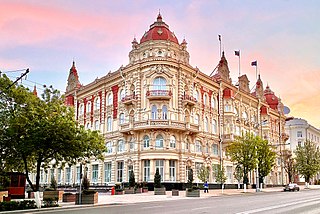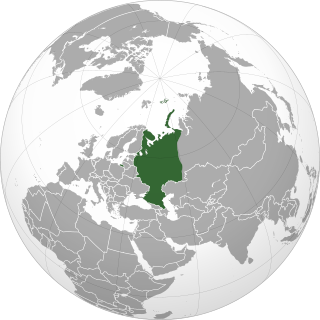
Rostov-on-Don is a port city and the administrative centre of Rostov Oblast and the Southern Federal District of Russia. It lies in the southeastern part of the East European Plain on the Don River, 32 kilometers (20 mi) from the Sea of Azov, directly north of the North Caucasus. The southwestern suburbs of the city lie above the Don river delta. Rostov-on-Don has a population of over one million people and is an important cultural center of Southern Russia.

Moscow Oblast, also known as Podmoskovye, is a federal subject of Russia. With a population of 8,524,665 living in an area of 44,300 square kilometers (17,100 sq mi), it is one of the most densely populated regions in the country and is the second most populous federal subject. The oblast has no official administrative center; its public authorities are located in Moscow and Krasnogorsk, and also across other locations in the oblast.

Voronezh is a city and the administrative centre of Voronezh Oblast in southwestern Russia straddling the Voronezh River, located 12 kilometers (7.5 mi) from where it flows into the Don River. The city sits on the Southeastern Railway, which connects western Russia with the Urals and Siberia, the Caucasus and Ukraine, and the M4 highway (Moscow–Voronezh–Rostov-on-Don–Novorossiysk). In recent years the city has experienced rapid population growth, rising in 2021 to 1,057,681, up from 889,680 recorded in the 2010 Census, making it the 14th-most populous city in the country.

European Russia is the western and most populated part of Russia. It is geographically situated in Europe, as opposed to the country's sparsely populated and vastly larger eastern part, which is situated in Asia, encompassing the entire northern region of the continent. The Ural Mountains divide Russia into two parts, bisecting the Eurasian supercontinent. European Russia covers the vast majority of Eastern Europe, and spans roughly 40% of Europe's total landmass, with over 15% of its total population, making Russia the largest and most populous country in Europe.

Kashira is a town and the administrative center of Kashirsky District in Moscow Oblast, located on the Oka River 115 kilometers (71 mi) south of Moscow. Population: 41,870 (2010 Census); 40,898 (2002 Census); 44,110 (1989 Census).

The Russian route M5 is a major trunk road running across a distance of 1879 km from Moscow to the Ural Mountains. It is part of the European route E30 and the Trans-Siberian Highway. The section from Yekaterinburg to Chelyabinsk is also part of AH7, and the section from Chelyabinsk to Moscow is also part of AH6.

The Russian route P22 is a major trunk road that links Moscow to the Caspian Sea. The road runs from Stupino, then heads southeast across Ryazan Oblast, Tambov Oblast, Voronezh Oblast, and Volgograd Oblast, running along the right bank of the Volga River through Volgograd before terminating at Astrakhan. Its length is 1381 kilometers. The entire route is part of European route E119, the stretch between Volgograd and Astrakhan is also part of European route E40, and the stretch between Borisoglebsk and Saratov is also a part of European route E38. The section from Kashira to Astrakhan is part of AH8, the section from Saratov to Borisoglebsk is part of AH61, and the section from Volgograd to Astrakhan is part of AH70. In 2018, the northern terminus was moved to the M4 south of Stupino, removing the concurrency with the M4. Before 2018 the route was designated as M6.

The Russian route M8 "Kholmogory" or Yaroslavl highway, is a major trunk road that links Moscow to the Russian North in general and the sea harbour of Arkhangelsk in particular. The road runs north of Moscow across a distance of 1271 kilometres through Mytishchi, Pushkino, Sergiyev Posad, Pereslavl-Zalessky, Rostov the Great, Yaroslavl, Danilov, Gryazovets, Vologda, Kadnikov, Velsk, Kholmogory, and Arkhangelsk, ending up in the city of Severodvinsk. It passes Moscow, Vladimir, Yaroslavl, Vologda, and Arkhangelsk Oblasts.

Dzhubga is a seaside resort situated 57 km west of Tuapse in Krasnodar Krai, Russia.

European route E 97 is an A-class European Route in Ukraine, Russia, Georgia, and Turkey. The highway runs for 1,360 kilometres (850 mi) in total. It connects the North Black Sea region with the South Black Sea region along the eastern shores of the sea.

The Yugo-Vostochnaya Railway is a subsidiary of the Russian Railways headquartered in Voronezh. Despite its name, the network operates the railways in the southwest of Russia. Its area of operation comprises Voronezh, Belgorod, Kursk, Ryazan, Tambov, Lipetsk, and Penza regions.

The Georgian S1 route, is a "road of international importance" with a registered length of 542.7 kilometres (337.2 mi) within the Georgian classification system, which makes it the longest Georgian highway route. It runs from Tbilisi via Mtskheta, Gori, Khashuri, Zestaponi, Kutaisi, Samtredia, Senaki, Zugdidi, Sukhumi and Gagra to the border with Russia near Leselidze at the northwestern tip of the country, covering in practice 537 kilometres (334 mi). After crossing the Georgia–Russia border in breakaway Abkhazia, the highway continues to Sochi and Krasnodar as A147. It is part of European E60, E97 and E117 routes and Asian Highways AH5, AH81 and AH82, and connects with six other S-routes.

European Route E 115 is a European B class road in Russia, connecting the cities Yaroslavl - Novorossiysk
The following is a timeline of the history of the city of Rostov-on-Don, Russia.
The 2006–07 Russian Cup was the 15th edition of the Russian football knockout tournament since the dissolution of Soviet Union. The competition started on 13 April 2006 and finished on 27 May 2007, with the final played at the Luzhniki Stadium in Moscow, where Lokomotiv Moscow beat FC Moscow 1–0 at extra time.
The 2021–22 Russian Cup was the 30th season of the Russian football knockout tournament since the dissolution of the Soviet Union. The competition qualification started on 14 July 2021 and it concluded on 29 May 2022. The final was attended by almost 70,000 fans at the Luzhniki Stadium.
The 2022–23 Russian Cup is the 31st season of the Russian football knockout tournament since the dissolution of the Soviet Union. The competition started on 16 August 2022 and concluded on 11 June 2023.

On 23 June 2023, the Wagner Group, a Russian government-funded paramilitary and private military company, staged a rebellion after a period of increasing tensions between the Russian Ministry of Defence and the then-leader of Wagner, Yevgeny Prigozhin. An agreement to settle this conflict was reached between the two sides the next day, 24 June 2023.
















